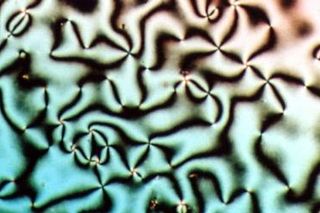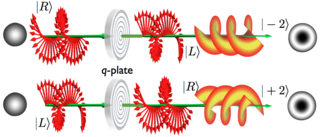Related Research Articles

Liquid crystals (LCs) are a state of matter which has properties between those of conventional liquids and those of solid crystals. For instance, a liquid crystal may flow like a liquid, but its molecules may be oriented in a crystal-like way. There are many different types of liquid-crystal phases, which can be distinguished by their different optical properties. The contrasting areas in the textures correspond to domains where the liquid-crystal molecules are oriented in different directions. Within a domain, however, the molecules are well ordered. LC materials may not always be in a liquid-crystal state of matter.
Electrowetting is the modification of the wetting properties of a surface with an applied electric field.
Deep-level transient spectroscopy (DLTS) is an experimental tool for studying electrically active defects in semiconductors. DLTS establishes fundamental defect parameters and measures their concentration in the material. Some of the parameters are considered as defect "finger prints" used for their identifications and analysis.

A super-twisted nematic display (STN) is a type of monochrome passive-matrix liquid crystal display (LCD).
In physics, photon-induced electric field poling is a phenomenon whereby a pattern of local electric field orientations can be encoded in a suitable ferroelectric material, such as perovskite. The resulting encoded material is conceptually similar to the pattern of magnetic field orientations within the magnetic domains of a ferromagnet, and thus may be considered as a possible technology for computer storage media. The encoded regions are optically active and thus may be "read out" optically.

Martin Schadt is a Swiss physicist and inventor.
Thermally stimulated current (TSC) spectroscopy is an experimental technique which is used to study energy levels in semiconductors or insulators. Energy levels are first filled either by optical or electrical injection usually at a relatively low temperature, subsequently electrons or holes are emitted by heating to a higher temperature. A curve of emitted current will be recorded and plotted against temperature, resulting in a TSC spectrum. By analyzing TSC spectra, information can be obtained regarding energy levels in semiconductors or insulators.
A blue phase mode LCD is a liquid crystal display (LCD) technology that uses highly twisted cholesteric phases in a blue phase. It was first proposed in 2007 to obtain a better display of moving images with, for example, frame rates of 100–120 Hz to improve the temporal response of LCDs. This operational mode for LCDs also does not require anisotropic alignment layers and thus theoretically simplifies the LCD manufacturing process.
Electrically operated display devices have developed from electromechanical systems for display of text, up to all-electronic devices capable of full-motion 3D color graphic displays. Electromagnetic devices, using a solenoid coil to control a visible flag or flap, were the earliest type, and were used for text displays such as stock market prices and arrival/departure display times. The cathode ray tube was the workhorse of text and video display technology for several decades until being displaced by plasma, liquid crystal (LCD), and solid-state devices such as thin-film transistors (TFTs), LEDs and OLEDs. With the advent of metal-oxide-semiconductor field-effect transistors (MOSFETs), integrated circuit (IC) chips, microprocessors, and microelectronic devices, many more individual picture elements ("pixels") could be incorporated into one display device, allowing graphic displays and video.
A liquid-crystal laser is a laser that uses a liquid crystal as the resonator cavity, allowing selection of emission wavelength and polarization from the active laser medium. The lasing medium is usually a dye doped into the liquid crystal. Liquid-crystal lasers are comparable in size to diode lasers, but provide the continuous wide spectrum tunability of dye lasers while maintaining a large coherence area. The tuning range is typically several tens of nanometers. Self-organization at micrometer scales reduces manufacturing complexity compared to using layered photonic metamaterials. Operation may be either in continuous wave mode or in pulsed mode.

Sorab (Soli) K. Ghandhi was a professor Emeritus at Rensselaer Polytechnic Institute (RPI) known for his pioneering work in electrical engineering and microelectronics education, and in the research and development of Organometallic Vapor Phase Epitaxy (OMVPE) for compound semiconductors. He was the recipient of the IEEE Education Award "For pioneering contributions to semiconductor and microelectronics education" in 2010.

Organic lasers use an organic material as the gain medium. The first organic laser was the liquid dye laser. These lasers use laser dye solutions as their gain media.

Organic photonics includes the generation, emission, transmission, modulation, signal processing, switching, amplification, and detection/sensing of light, using organic optical materials.
Vasily Astratov is a full professor of Physics and Optical Science at the University of North Carolina at Charlotte. He became known for launching synthetic opals as new self-assembled photonic crystals for visible light in 1995 in his former group at Ioffe Institute in Russia. This work has resulted in a quest for inverse opals with a complete three-dimensional Photonic band gap
Richard Magee Osgood Junior. is an American applied and pure physicist. He is currently Higgins Professor of Electrical Engineering and Applied Physics at Columbia University.
Optoelectrowetting (OEW) is a method of liquid droplet manipulation used in microfluidics applications. This technique builds on the principle of electrowetting, which has proven useful in liquid actuation due to fast switching response times and low power consumption. Where traditional electrowetting runs into challenges, however, such as in the simultaneous manipulation of multiple droplets, OEW presents a lucrative alternative that is both simpler and cheaper to produce. OEW surfaces are easy to fabricate, since they require no lithography, and have real-time, reconfigurable, large-scale manipulation control, due to its reaction to light intensity.

Guest Host Displays, Dichroic Displays, Polymer Dispersed Displays

A q-plate is an optical device which can generate light beams with orbital angular momentum of light (OAM) from a beam with well-defined Spin angular momentum of light (SAM). It is currently realized using liquid crystals, polymers or sub-wavelength gratings.
Photoalignment is a technique for orienting liquid crystals to desired alignment by exposure to polarized light and a photo reactive alignment chemical. It is usually performed by exposing the alignment chemical to polarized light with desired orientation which then aligns the liquid crystal cells or domains to the exposed orientation. The advantages of photoalignment technique over conventional methods are non-contact high quality alignment, reversible alignment and micro-patterning of liquid crystal phases.

Yuriy Reznikov was a Ukrainian physicist, Head of the Department of Crystals at NASU Institute of Physics and a world-renown expert in the field of liquid crystals. He is known for his work on photoalignment, "giant" optical non-linearity of liquid crystals and nano-colloids.
References
- ↑ Heilmeier, G. H.; Zanoni, L. A. (1968). "GUEST‐HOST INTERACTIONS IN NEMATIC LIQUID CRYSTALS. A NEW ELECTRO‐OPTIC EFFECT". Applied Physics Letters. AIP Publishing. 13 (3): 91–92. doi:10.1063/1.1652529. ISSN 0003-6951.
- ↑ Schadt, M.; Helfrich, W. (1971-02-15). "VOLTAGE‐DEPENDENT OPTICAL ACTIVITY OF A TWISTED NEMATIC LIQUID CRYSTAL". Applied Physics Letters. AIP Publishing. 18 (4): 127–128. doi:10.1063/1.1653593. ISSN 0003-6951.
- ↑ Scheffer, T. J.; Nehring, J. (1984-11-15). "A new, highly multiplexable liquid crystal display". Applied Physics Letters. AIP Publishing. 45 (10): 1021–1023. doi:10.1063/1.95048. ISSN 0003-6951.
- ↑ Soref, R.A. (1973-02-15). "Transverse field effects in nematic liquid crystals". Applied Physics Letters. AIP Publishing. 22 (4): 165–166. doi:10.1063/1.1654597. ISSN 0003-6951.
- ↑ Schiekel, M. F.; Fahrenschon, K. (1971-11-15). "Deformation of Nematic Liquid Crystals with Vertical Orientation in Electrical Fields". Applied Physics Letters. AIP Publishing. 19 (10): 391–393. doi:10.1063/1.1653743. ISSN 0003-6951.
- ↑ K. Ohmuro, et al., SID'97 Digest, p. 845
- ↑ J. O. Kwag, et al., SID'00 Digest, p. 1077
- ↑ Bos, Philip J.; Koehler/beran, K. Rickey (1984). "The pi-Cell: A Fast Liquid-Crystal Optical-Switching Device". Molecular Crystals and Liquid Crystals. Informa UK Limited. 113 (1): 329–339. doi:10.1080/00268948408071693. ISSN 0026-8941.
- ↑ White, Donald L.; Taylor, Gary N. (1974). "New absorptive mode reflective liquid‐crystal display device". Journal of Applied Physics. AIP Publishing. 45 (11): 4718–4723. doi:10.1063/1.1663124. ISSN 0021-8979.
- ↑ Berreman, D. W.; Heffner, W. R. (1980). "New bistable cholesteric liquid‐crystal display". Applied Physics Letters. AIP Publishing. 37 (1): 109–111. doi:10.1063/1.91680. ISSN 0003-6951.
- ↑ G. P. Brown, Proc. IDRC 2000, p. 76